Birth Flower by Month
For centuries, cultures around the world have connected birthdays to flowers, assigning a specific bloom to each month. This tradition of birth flowers ties personal milestones to nature’s cycles. People believe that a child’s birth flower carries special meaning and charm unique to that month. These flowers are used in birthday bouquets, decorations, and gifts. They bring color and tradition into celebrations, making each birthday feel personalized. In this guide, we’ll explore the birth flower for each month from January through December – its symbolism, botany, gift ideas, and ideal occasions.
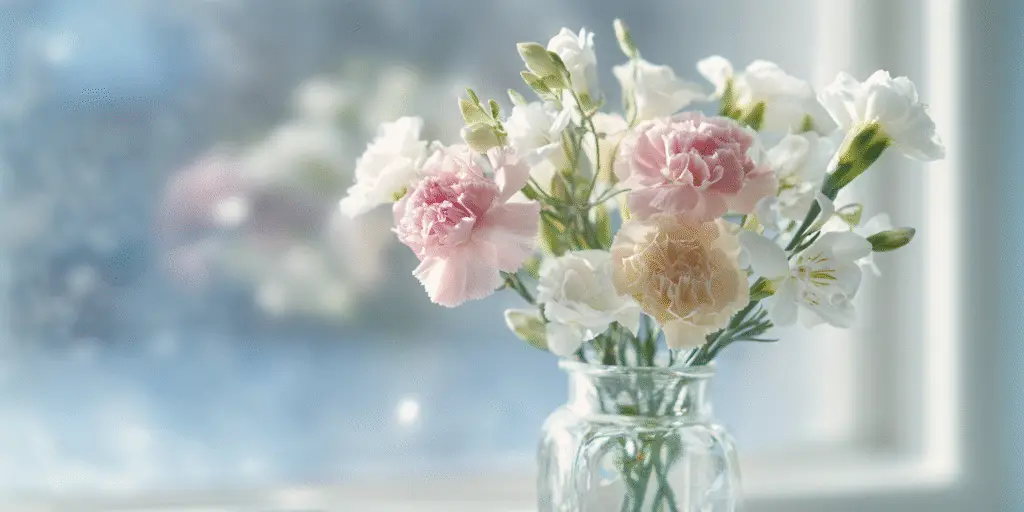
January: Carnation and Snowdrop
January’s crisp winter days bring forth two birth flowers: the carnation and the snowdrop. The Carnation (Dianthus caryophyllus) is a ruffled bloom found in a rainbow of colors. It has long symbolized devotion and love. Historically painted in still lifes and given at weddings, carnations carry stories of admiration. Red carnations proclaim deep passion, pink ones mean gratitude, and white ones stand for pure admiration. The delicate snowdrop, with its nodding white bells, represents hope and renewal. One of the first flowers of spring, snowdrops often emerge through the last snows, symbolizing purity and new beginnings. Together, the January flowers remind us that even in the coldest month, love and hope endure.
Botanically, carnations are hardy perennial plants originally from the Mediterranean. Garden carnations grow in clumps of narrow green leaves and can reach up to 2 feet tall. They have stiff, branching stems and often give off a spicy, clove-like scent. Carnations come in standard, miniature, and spray forms, and many garden varieties have frilled or double blooms. Snowdrops (Galanthus nivalis) are small bulbous perennials only 6-10 inches high. Each snowdrop stem bears a single white, bell-like bloom and a pair of grasslike leaves. They spread quietly in shaded gardens, returning each spring.
For gifting and décor, carnations are beloved for their sturdy blooms and long vase life. They are famous Mother’s Day flowers, and white carnations in particular honor memory and maternal love. Brightly colored carnations work well in bouquets for birthdays and anniversaries. Snowdrops make charming early-spring gifts or accents in wedding arrangements as promises of spring. Both flowers suit occasions of love and hope, from weddings to new baby celebrations. In winter weddings especially, snowdrops are often included to symbolize hope and enduring love. One January tradition is giving carnations on New Year birthdays and during Valentine’s bouquets, symbolizing affection that lasts into the coming year. Carnations were cultivated by ancient Greeks and Romans in formal gardens and used for celebratory garlands. For example, pink carnations are a modern symbol of a mother’s love, reinforcing January’s themes of family and devotion.

February: Violet and Primrose
February’s birth flowers are the violet and the primrose. Violets (genus Viola) are delicate woodland perennials with heart-shaped leaves and small five-petaled blooms. They traditionally symbolize modesty, faithfulness, and loyal affection. In Victorian flower language, a bouquet of violets meant lasting love and devotion. In folklore, violets were sometimes called “women’s flannel” for their soft petals. Primroses (Primula) bloom in early spring with clusters of pale yellow flowers (garden varieties also appear in pink, lavender, or white). Their name literally means “first rose,” and they symbolize youth, new beginnings, and optimism – hopeful tokens of spring’s return. These star-shaped blooms hint at the freshness of spring even when winter still lingers.
Botanically, violets grow low to the ground, forming mats of green leaves and 3-6 inch stalks topped by purple, white, or blue blossoms. They thrive in part shade and rich soil, often self-seeding under trees. Many species form colonies in woodland edges. Primroses also prefer cool, moist sites: they form basal rosettes of wrinkled leaves and send up multiple slender stems of flowers. Many garden primroses and polyanthus varieties have double or multi-colored blooms, and they often naturalize in beds and lawns. Both violets and primroses bloom in late winter or early spring, bringing a bright spot of color during February.
For gifting, violets and primroses are charming and sweet. A small posy of violets can express admiration and sincere affection, perfect for a Valentine’s bouquet symbolizing loyalty. Primroses make delightful potted or cut-flower gifts, symbolizing fresh starts and optimistic new beginnings. Both flowers bring a splash of cheer to late-winter celebrations, lifting spirits with their bright faces. Because they herald spring, they suit Easter baskets, new baby showers, or simply brightening someone’s day with a reminder that warmer days are coming. Victorian gardeners even celebrated violets each year in spring festivals, and primroses were carried in love letters as tokens of affection. In some traditions, violet dye was used in early spring crafts, reinforcing the idea of renewal and friendship. In old folklore, planting primroses near the home was thought to bring good luck and protection.
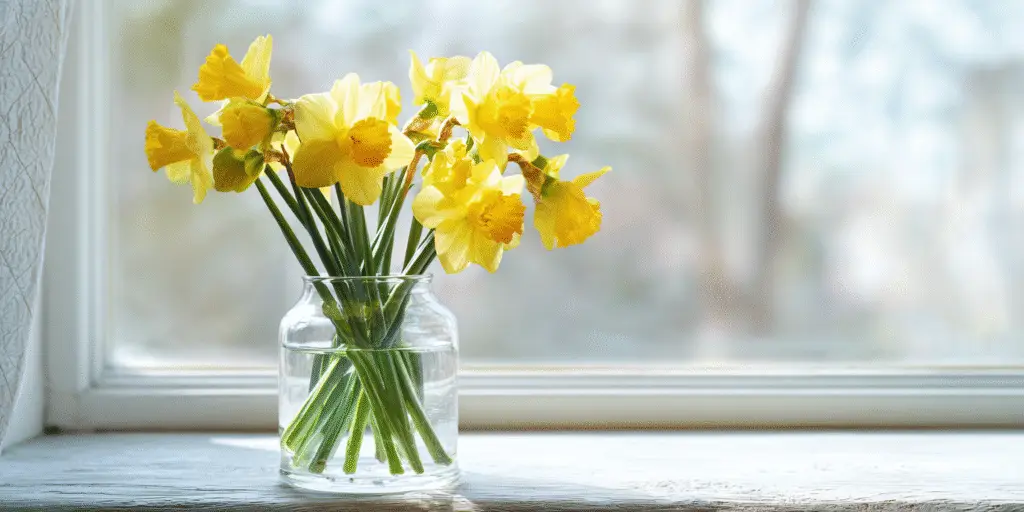
March: Daffodil
March brings bright daffodils and jonquils as birth flowers. The daffodil (Narcissus) is a cheerful trumpet-shaped bloom, most often yellow or white. Daffodils symbolize rebirth, renewal, and hope, fitting for spring’s arrival. A vase of daffodils is said to bring good luck and happiness. In Welsh culture, the daffodil is celebrated on St. David’s Day as a sign of good fortune. Jonquils, close cousins of daffodils, have clusters of small fragrant yellow flowers. They share the theme of new beginnings and also represent affectionate love and desire. These golden blooms together announce the end of winter. In literature and art, daffodils often appear as symbols of inspiration and new life (as in Wordsworth’s famous poem).
Botanically, daffodils are bulbous perennials producing tall, linear green leaves and 6-24 inch flower stalks. Each stout stem typically bears a single showy bloom or a small cluster of trumpets. Daffodils come in pure yellow, white, and bi-color varieties, with many cultivars having large, double flowers or orange-yellow centers. Jonquils are also Narcissus bulbs, often with grasslike foliage and several smaller blooms per stem. Both bloom in early spring and naturalize readily in garden beds and woodland edges, forming drifts of yellow each year. Gardeners often divide and share bulbs, so patches of daffodils multiply over time. These flowers are among the first to bloom after frost, making them a joyful sight in March gardens.
For gifting, daffodils make a bold statement on their own. Florists often arrange them alone in a tall vase so they can share their vibrant energy. They suit occasions like graduations, weddings, or any spring birthday. One kind gesture is that giving a bunch of daffodils to someone is said to grant them good fortune in the coming year. Jonquils, with their sweet scent, add romance to any bouquet. Because daffodils signify good fortune and rebirth, it’s a kind gesture to give them to someone starting a new chapter. Both flowers embody springtime joy and are perfect for celebrating renewal – new jobs, new babies, or simply welcoming warmer days ahead. For example, daffodils are often included in Easter arrangements, symbolizing the season of life, while jonquils were once used in love potions for their heady perfume.
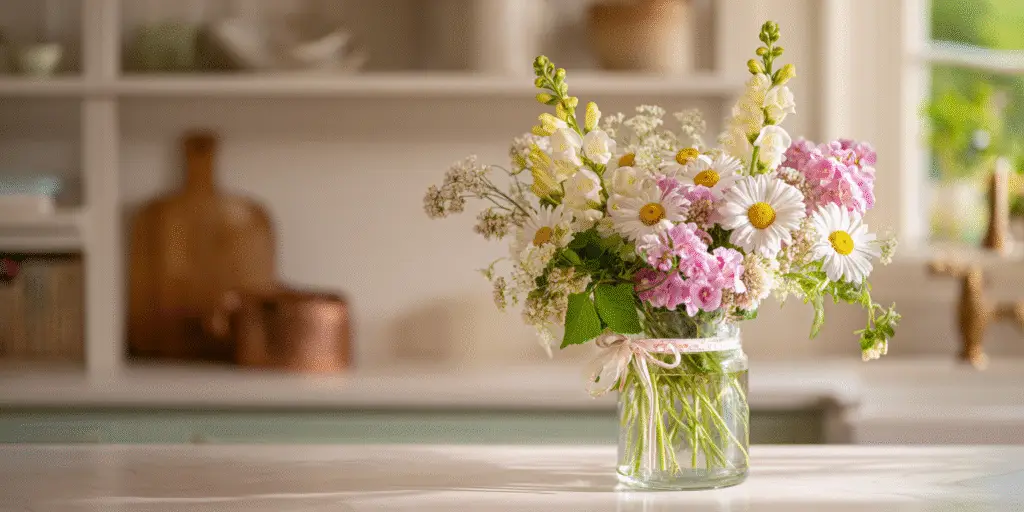
April: Daisy and Sweet Pea
April’s birth flowers are the daisy and the sweet pea. Daisies (often represented by Gerbera daisies) are sunny flowers with round petals symbolizing innocence, purity, and new beginnings. They have long been seen as happy, loyal blooms that convey cheerfulness and true love. The daisy’s simple face evokes warmth and affection. Sweet peas (Lathyrus odoratus) are delicate climbing blossoms with a captivating fragrance. Their name comes from a Greek myth (the nymph named “Aura” turned into a breeze, inspiring the scent). In flower language, sweet peas convey gratitude, blissful pleasure, and tender farewells. They are a classic old-fashioned garden flower, often given to say “thank you” or “goodbye with thanks.” In Victorian times, sweet peas symbolized blissful pleasure, so a bouquet of sweet peas was a gracious way to express kind sentiments.
Botanically, Gerbera daisies grow as clumping perennials with thick stems and large 3-4 inch blooms in shades of white, pink, orange, and red. Native to South Africa, they thrive in sunny garden beds with rich soil. There are double and single forms, but all have that iconic central disk. Sweet peas are tender annual vines: they climb using twining tendrils on supports like trellises. They bear ruffled pea-family flowers in pastel pinks, purples, and whites. Often started from seed in late winter, sweet peas shoot up quickly in cool spring weather, reaching 6-8 feet tall with blooms lasting several weeks. Gardeners may cover sweet peas with netting until mid-spring to give them early support. The combination of daisies at ground level and sweet peas reaching upwards makes April gardens charmingly layered.
For gifting, daisies are versatile crowd-pleasers. A bright daisy bouquet suits birthdays, Mother’s Day, or cheerful get-well wishes with its innocent charm. Sweet peas make elegant springtime gifts: their heady fragrance is perfect for weddings, garden parties, or thank-you bouquets. They carry an air of nostalgia and grace, symbolizing joy and gratitude. Both flowers add a delicate spring beauty: daisies for bright, joyful occasions and sweet peas for intimate, heartfelt moments. In many gardens, these cheerful blooms grow alongside tulips during the spring bloom. Sweet peas were so prized in Victorian England that they inspired annual flower shows; even today, wedding decorators will include sweet peas for their scent. Gerbera daisies are now popularly used by florists to brighten any bouquet with good cheer, echoing the daisy’s meaning of loyal love.
April is also a time when other cheerful blooms appear in gardens – for example, colorful tulips often bloom at the same time, so April arrangements may mix tulips, daisies, and sweet peas for an uplifting spring display. This combination captures all aspects of April’s spirit: cheerful daisies for joy, fragrant sweet peas for gratitude, and bright tulips for the full burst of spring color.
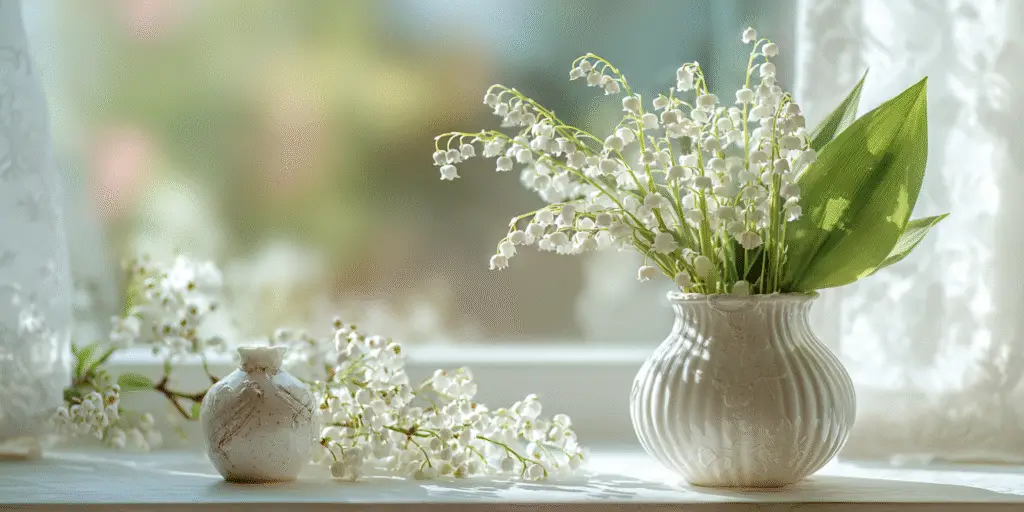
May: Lily of the Valley and Hawthorn
May’s birth flowers are the lily-of-the-valley and the hawthorn. Lily-of-the-valley (Convallaria majalis) is a delicate woodland plant with fragrant white bell-shaped flowers on slender stems. It symbolizes purity, humility, and the return of happiness. In Christian legend it is sometimes called “Our Lady’s tears,” while in flower language it brings good luck and renewal. The lily-of-the-valley’s beautiful scent made it a favorite in bridal bouquets (Queen Victoria famously carried them in her wedding). Hawthorn blooms in clouds of small white flowers on thorny shrubs or small trees. In folklore, the hawthorn flower represents hope, love, and protection. Celtic traditions associate hawthorn with fertility, and it is often called the May-tree. The emergence of hawthorn flowers has long marked May Day festivals in Europe, honoring spring’s abundance.
Botanically, lily-of-the-valley is a cool-climate perennial about 6-12 inches tall, with pairs of glossy green leaves. Each arching stalk carries multiple tiny white bells. It spreads underground by rhizomes, forming fragrant carpets in spring. Lily-of-the-valley flowers are highly sensitive to heat, so they are happiest in shaded gardens where their perfume can linger. Hawthorn (Crataegus) is a hardy shrub or small tree up to 15-30 feet (4-9 m) tall. Each spring it is covered in clusters of five-petaled white flowers, creating a cloud of blooms that often smells faintly of almonds. Later it produces bright red berry-like fruits (called haws) in autumn. Many wild hawthorn trees have a storied history – they often grow near ancient sites and were considered protective of the land.
For gifting, lily-of-the-valley is a beloved wedding flower. It was the bouquet of choice for several royal weddings and remains a symbol of marital happiness. Its sweet scent also makes it a wonderful spring bouquet for Mother’s Day or birthdays. Hawthorn is not often cut for bouquets, but its appearance signals a celebratory time: in May Day traditions, its blooms were woven into garlands and wreaths for good luck. Both flowers celebrate spring’s promise and are perfect for events that honor new life, love, and heartfelt wishes. Historically, people believed hanging hawthorn branches in homes protected against evil spirits. Gardeners delight when lily-of-the-valley spreads under trees or along borders, seeing it as a good omen. These May flowers remind us of honor, fidelity, and the warmth of family and community that grows in spring.
May has a special folklore tie to hawthorn: Legend says that harming a hawthorn was bad luck, as it might offend the fairies that guard it. This adds a playful, magical touch to the tree’s symbolism of hope and protection. Lily-of-the-valley’s beautiful fragrance and humble stature also reinforce its message: even the smallest pure-hearted gestures bring happiness and renewal.
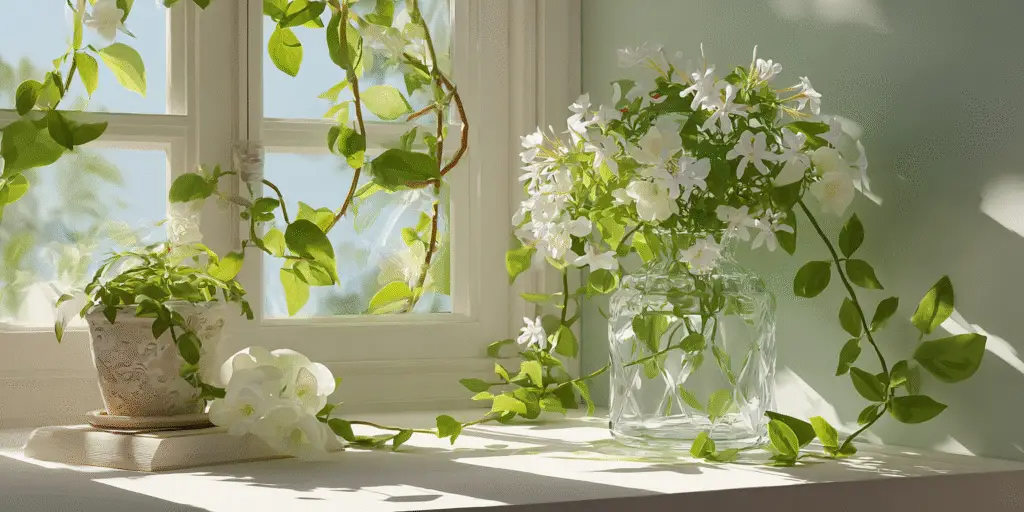
June: Rose and Honeysuckle
June’s birth flowers are the roses (plural) and the honeysuckle. Roses (Rosa) are timeless emblems of love, beauty, and devotion, treasured around the world. They have held romantic meaning for centuries across cultures. Each color of rose has its own nuance: red for passion, pink for admiration, white for purity, and yellow for friendship. Even the form of the bloom can carry significance: a delicate bud represents youth, a full blossom signifies warmth. Honeysuckle (Lonicera) is a fragrant climbing vine with tubular blossoms. Its summer blooms symbolize happiness, sweet affection, and good fortune, and they often tumble over garden walls, perfuming warm evenings. Honeysuckle vines might wind around a porch, creating a sweet border – this tying together of plant and home mirrors the bond of devotion the flower represents.
Botanically, roses are woody shrubs or vines with thorny stems. They come in thousands of varieties – from compact tea roses to towering climbers – and in virtually every color (including multicolored). Cultivated roses may have large multi-layered petals or simple open blooms. Honeysuckle vines are vigorous growers that twist around supports like trellises or fences. They produce clusters of tubular flowers in shades of white, yellow, or pink. Many honeysuckles have a powerful sweet scent and even produce red berries later in the summer. The blooms attract hummingbirds and bees, and they perfume the garden all summer long, embodying the warmth of June. Honeysuckles are hardy and fast-growing; a planted cutting can quickly become a lush hedge of fragrance.
For gifting, roses are quintessential: red roses for anniversaries and Valentine’s Day, pink or white roses for weddings, and yellow roses to celebrate friendship or a special milestone. They work for almost any occasion. Honeysuckle’s intoxicating fragrance makes it a lovely addition to summer bouquets and garden displays. In the Victorian language of flowers, honeysuckle was a symbol of devoted love, so giving honeysuckle suggests enduring affection and luck. Both flowers embody the warmth and joy of June, making them perfect for weddings, graduations, or romantic celebrations on sunny days. Roses also feature in many anniversaries: the 15th wedding anniversary flower is traditionally roses, linking forever-love to June’s touch. Honeysuckle vines with entwined stems also made them symbols of union and friendship.
Roses even have connections in mythology: Aphrodite’s tears turned into the first white rose, making it a symbol of purity and new beginnings. Honeysuckle, conversely, was said to be one flower that the god Pan played in the forest, earning it a mythic status for symbolizing blissful pleasure. Together, these June flowers teach us that love and happiness blossom in full warmth and commitment.

July: Larkspur and Water Lily
July’s birth flowers are the larkspur and the water lily. Larkspurs (Delphinium) are tall spires of vivid blooms in blue, purple, pink, or white. They symbolize positivity, cheerfulness, and an open heart. In floral tradition, they convey lighthearted enjoyment and goodwill. Larkspur’s many petals, arranged like a fairy tower, bring a playful grandeur to summer gardens. Water lilies (Nymphaea) are serene pond flowers with round floating leaves and fragrant blossoms. Each day they open fresh above the water, symbolizing purity, rebirth, and spiritual enlightenment. Often depicted in art and literature, water lilies carry a sense of peace and majesty. The combination of the sky-reaching larkspur and the tranquil water lily captures July’s dual spirit of exuberance and calm.
Botanically, larkspurs are perennial plants with tall hollow stems that can reach 3-6 feet. Each sturdy stem bears tiered clusters of 1-2 inch blooms that attract pollinators like butterflies. Delphiniums prefer cool summers and rich, well-drained soil, making them a classic of cottage gardens and an iconic summer bloom. They often reseed, so a patch can reappear each year. Water lilies are aquatic perennials. Each plant has floating round lily pads and fragrant flowers. Blooms of white, pink, or yellow open each morning on the water’s surface, creating a tranquil summer scene in ponds. Water lilies have specialized stems that root in muddy pond bottoms, allowing their leaves to drift. They continue to open for much of the day and close at night.
For gifting, larkspur brings architectural beauty to summer bouquets and garden displays. They celebrate achievement and joy, making them fitting for graduation or community celebration bouquets. Water lilies, being aquatic, aren’t used in standard bouquets, but their image suggests calmness and purity. You might include a water lily motif in arrangements for a serene ceremony or give lily-themed gifts for extra tranquility and summertime serenity. In floral art and craft, water lilies are often painted or embroidered to invoke peace. Both flowers capture July’s spirit: larkspur for joyous celebrations and water lilies for peaceful summer days. Larkspurs are also the birth flower of the state of Idaho, and water lilies are the state aquatic flower of Missouri, showing how states recognize these blooms.
One folklore notes that morning dew on larkspur petals was believed to give courage to anyone who drank it. Water lilies are sometimes confused with lotuses, but unlike the sacred lotus, water lilies live in colder climates and are prized for their wide, open flowers.
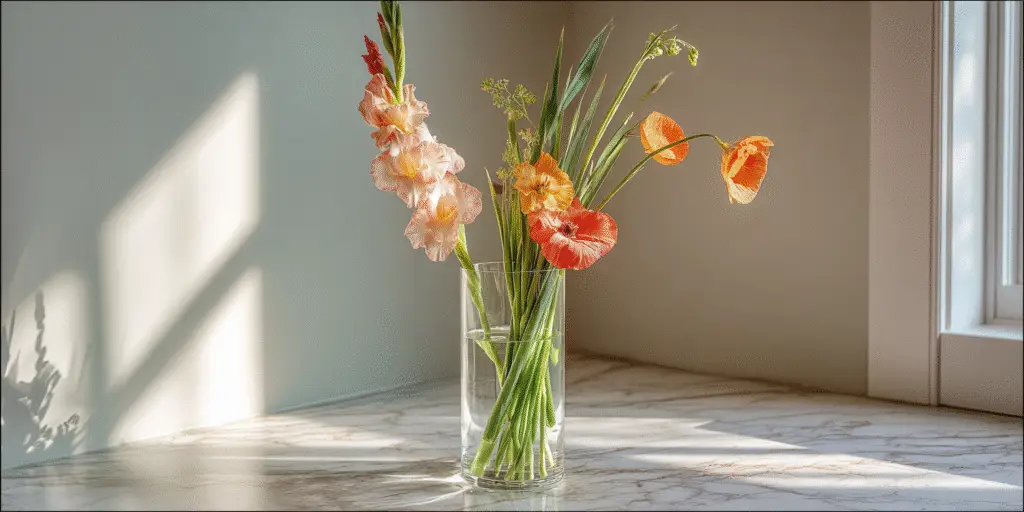
August: Gladiolus and Poppy
August’s birth flowers are the gladiolus and the poppy. Gladiolus blooms grow in tall spikes and symbolize strength of character, integrity, and moral courage. These blooms stand erect like swords and were named after the Roman gladiators’ weapons (Latin “gladius” means sword). Bright poppies (Papaver) in shades of red or orange evoke imagination and remembrance. Together they add vibrance to late summer gardens. For example, gladiolus were used in ancient ceremonies to symbolize victory and honor fallen heroes. Ancient legends tell that gladiolus springs appeared where warriors fell, reinforcing its theme of remembrance. The vivid red poppy was later adopted as a symbol of memory after wartime battles (as in World War I), giving it an additional layer of meaning.
Botanically, gladiolus are tender perennials grown from corms. They can reach 4-5 feet tall, with sword-shaped leaves and funnel-shaped flowers in many colors. Each robust stem produces a row of flowers from base to tip. Poppies include annual and perennial species. Their delicate, papery flowers sit atop long stems and open in summer, often for just a day. The common red poppy is well known, but poppies also come in pink, white, and yellow. Poppies are notable for their abundant pollen and attractive seed pods after blooming. These late summer flowers provide texture and energy to the garden just before fall.
For gifting, gladiolus spikes make dramatic bouquets. A spike of gladiolus speaks of admiration and strength, making it suitable for anniversaries or to honor someone’s resilience. Gladiolus is also the traditional flower for a 40th anniversary in many Western lists. Poppies, especially bright scarlet or orange ones, are often used in remembrance ceremonies or as a creative splash in warm bouquets (though field poppies can wilt fast when cut). August’s flowers capture summer’s bold spirit: gladiolus for confident celebrations and poppies for thoughtful remembrances. Gladiolus bulbs were also given in Ancient Rome as talismans of strength.
Gladiolus and poppies both teach aspects of August: poppies bloom abundantly but briefly, reminding us to appreciate fleeting beauty, while gladiolus stand firm and tall, reminding us of enduring strength. In Victorian flower language, poppies could convey imagination or a lively soul, fitting summer’s creative vibe.
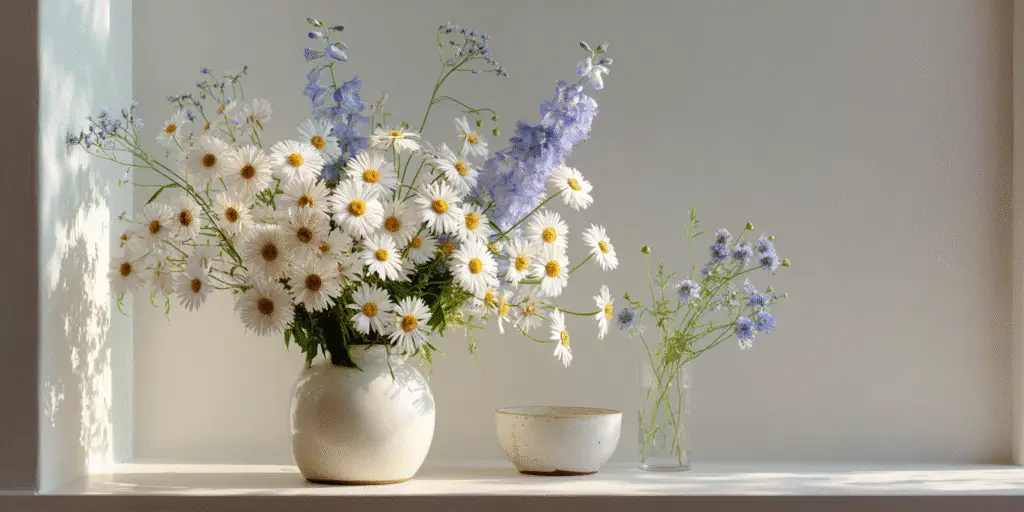
September: Aster and Morning Glory
September’s birth flowers are the aster and the morning glory. Asters are star-shaped daisy flowers that bloom in late summer and into fall. They symbolize love, wisdom, faith, and innocence. These starry blooms have been cherished since antiquity as symbols of patience and charm. Morning glories (Ipomoea) are twining vines with trumpet-shaped flowers that unfurl at dawn. They represent love, affection, and the promise of renewal. These flowers begin opening in the early morning light, making them beautiful heralds of each new day in September.
Botanically, asters are hardy perennials or subshrubs with clusters of daisy-like blooms in shades of pink, purple, blue, and white. They often reach 1-3 feet tall and provide late-season color in gardens. Several species grow with many small flowers on branching stalks. Morning glories are vigorous annual vines with heart-shaped leaves and 3-4 inch trumpet blooms. They climb fences or trellises up to 10 feet high. Each flower opens in sunlight and usually closes by afternoon, but new ones open daily through late summer. These flowers continue flowering into autumn when pollinated by bees and hummingbirds.
For gifting, asters add elegance and sincere affection to bouquets. They make lovely birthday or friendship flowers in late summer hues. Morning glories are less common as cut flowers (since they only last a day), but growing them in a garden or pot gifts the symbolism of unwavering love and optimism. Because they bloom with the morning sun, morning glories are often used to congratulate new beginnings, like a new job or a new home. Both flowers capture September’s gentle energy: asters for thoughtful devotion and morning glories for hopeful renewal. Interestingly, asters are official state flowers for states like New York and Pennsylvania, and morning glories have been celebrated at Japanese flower festivals, showing their cultural significance. In folklore, planting asters was thought to bring patience, and morning glories were believed to encourage one to live in the present moment.
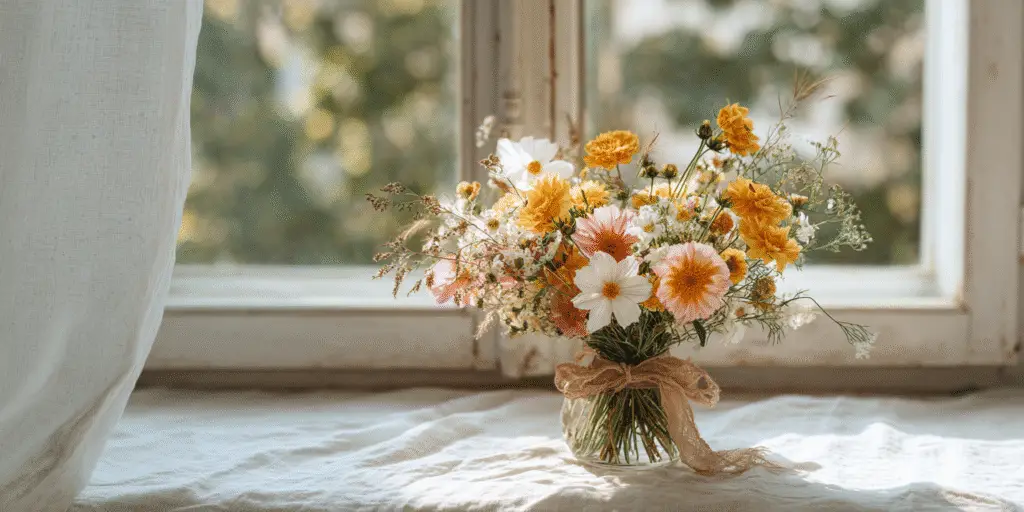
October: Marigold and Cosmos
October’s birth flower is the marigold. Marigolds are bright orange, yellow, or red blooms symbolizing joy, creativity, and warmth. They are often called “Mary’s gold” due to their link to the Virgin Mary in folklore, giving them religious and festive significance. Marigolds’ cheerful flowers are tied to celebration and remembrance (for example, Day of the Dead festivals use marigolds heavily to honor ancestors). Their bold colors capture autumn’s fiery beauty. The cosmos flower (Cosmos bipinnatus) is a dainty, daisy-like flower whose name means “harmony” in Greek. It represents order, balance, and peace, although it is not linked by birth month in most traditions. Both of these flowers are commonly seen in October gardens, adding layers of color and meaning.
Botanically, marigolds include both African and French varieties (Tagetes) as well as the pot marigold (Calendula). All are sun-loving annuals with ferny foliage. They form bushy mounds covered in single or double flowers that bloom profusely from summer until frost. Marigolds belong to the sunflower family, which explains their bright, sun-like appearance. Gardeners even use them as companion plants to deter pests. The pot marigold (Calendula officinalis) has edible petals and herbal uses in teas and salves. Cosmos are tall annuals with airy, fern-like leaves and single daisy blooms on slender stems. They can reach 3-6 feet tall, with flowers in white, pink, orange, or red continuing well into autumn. Cosmos self-seed easily; gardeners often find them returning year after year from saved seeds.
For gifting, marigolds bring brightness to autumn bouquets and potted gifts. They suit fall festivals, harvest décor, or as an exuberant “just because” arrangement. Potted marigolds are a common sight at pumpkin patches and farmers’ markets in October. Cosmos, with their gentle meaning of peace, are perfect for thank-you bouquets or casual garden posies. Gardeners often pluck spent cosmos blooms to encourage more flowers; giving cosmos suggests ongoing growth and friendship. Both flowers celebrate the rich colors of October, making them ideal for Halloween or birthday arrangements that embrace autumn’s warmth. For example, marigold orange pairs beautifully with Halloween pumpkins, while cosmos in pink and red add softness. Many gardeners plant marigolds at Day of the Dead altars as symbols of the sun and remembrance.
Marigold petals have been used in cooking and dyeing (“poor man’s saffron”), showing their sunny color even nourishes traditions. Cosmos seeds were once given to children to teach gardening, symbolizing nurturing new life. In these ways, October’s flowers bring creative warmth and peaceful balance to the season.
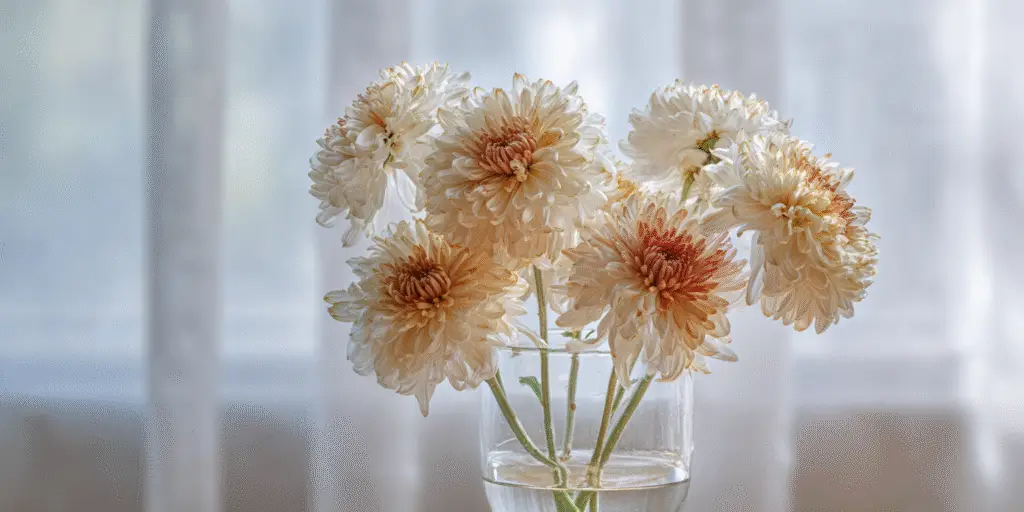
November: Chrysanthemum
November’s birth flower is the chrysanthemum, often called the “mum.” This showy bloom comes in many forms – from simple daisy petals to fluffy pom-poms. Chrysanthemums symbolize friendship, happiness, and long life. They light up autumn gardens with optimism and warmth. In Asia, mums represent longevity and royalty (a chrysanthemum crest is Japan’s national symbol), while in the West they are festive symbols of cheer. In fact, Australians gift mums on Mother’s Day, and in the language of flowers they convey heartfelt well-wishes. Historically, mums were also considered symbols of the sun due to their bloom timing and color.
Botanically, chrysanthemums are hardy perennial plants in the daisy family. Garden mums often grow in clumps 1-2 feet tall with dark green foliage. Varieties include spoon-petaled forms, spider-like blooms, and globe pom-poms. They bloom in rich autumn colors: golden yellows, fiery oranges, deep reds, and pure whites. Chrysanthemums are short-day plants, meaning they naturally flower in fall as daylight decreases. Many hardy mums in gardens will bloom around October or November without forcing, adding late-season color after summer flowers have faded. They can also be grown in pots and brought indoors in autumn to prolong their bloom. Chrysanthemum tea is popular in China, further symbolizing good health and friendship.
For gifting, chrysanthemums are versatile fall favorites. They make beautiful centerpieces for Thanksgiving tables and autumn weddings, and they brighten up fall birthdays. A bouquet of mixed-color mums says “I care about you” with warmth, similar to how a golden yellow mum once meant cheer. They also represent loyalty and joy in Victorian flower language. (Note: in some European countries, white chrysanthemums are reserved for remembrance, so flower color may change the meaning.) Overall, mums bring vitality and comfort to November gatherings, embodying the cozy, celebratory spirit of late autumn. For example, orange mums in a harvest bouquet mirror the colors of Thanksgiving. Chrysanthemums were even used in ancient art as symbols of the sun’s power. Their ability to bloom despite chilly weather reinforces their message of endurance and cheer in late fall.
November flowers also feature in cultural festivals. In Japan, chrysanthemums are celebrated at the “Festival of Happiness,” and in Europe they brighten All Saints’ Day altars. No matter the occasion, mums bring a vibrant reminder that joy can thrive even as the days grow shorter.
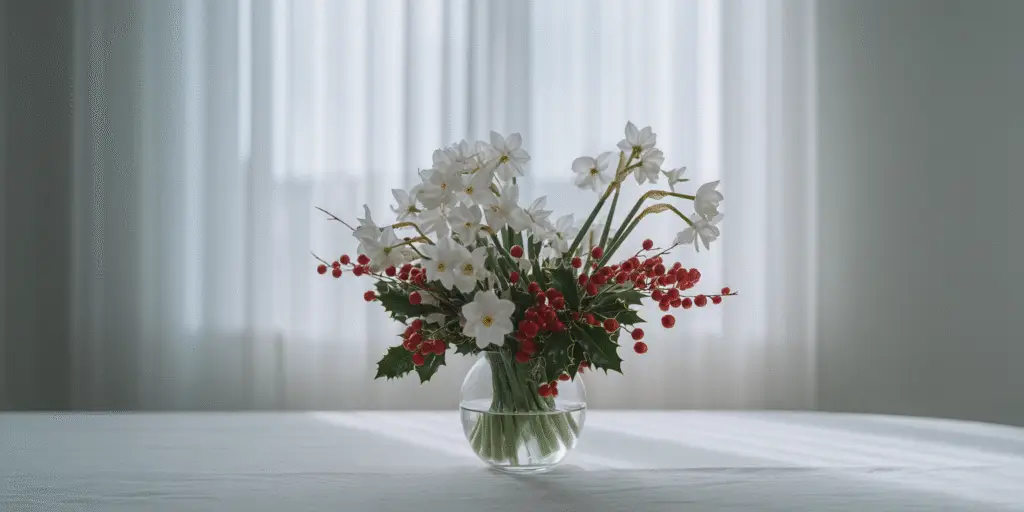
December: Narcissus and Holly
December’s birth plants are the paperwhite narcissus and the holly. Paperwhite narcissus (Narcissus tazetta) is a fragrant white bulb with clusters of star-like blooms. It symbolizes hope, devotion, and pure love. Giving paperwhites in December conveys warm wishes for happiness and renewal. Paperwhites can be forced to bloom indoors during the holidays, often filling a home with sweetness. Holly (Ilex) is an evergreen shrub with glossy spiky leaves and bright red berries. In folklore, holly represents protection and good fortune. Its presence at Christmas is tied to happiness and optimism. Early Christians likened holly’s red berries to hope and its sharp leaves to the crown of thorns, making holly a powerful symbol of Christmas cheer.
Botanically, paperwhite narcissus is a hardy bulb related to daffodils. It produces clusters of white trumpet flowers above a skirt of green leaves. Paperwhites naturally bloom in winter when forced indoors. They were introduced to Europe in the 18th century and became popular Christmas plants because they bloom when little else does. Their sweet fragrance can fill a room. Holly is a woody shrub or small tree; female plants carry the bright red berries used in winter decor. The plant stays green through winter, adding cheer when few other plants do. (Berries are toxic if eaten, so holly is used mainly for decoration rather than consumption.) Holly branches are often woven into wreaths and garlands. The name “holly” may derive from the word “hallow,” reflecting its sacred use in winter festivals.
For gifting, paperwhite bulbs are a lovely holiday tradition: they can be potted or forced to bloom in time for Christmas, symbolizing hope and new beginnings. You might see them on Christmas morning or in a festive windowsill. Holly’s green and red boughs add natural cheer to wreaths and arrangements, perfect for Christmas decorations. In winter bouquets or table decor, a sprig of holly instantly evokes the holiday spirit and protection. Both plants celebrate the festive season: narcissus with the promise of spring ahead, and holly with the warmth of Christmas. They brighten the darkest days of winter and are ideal for holiday celebrations and December birthdays. For example, including holly and paperwhites in a December celebration brings a bright note of joy to the year’s end. In pagan tradition, holly was even thought to bring good fortune to homes in midwinter, aligning with its modern symbolism of good luck and optimism.